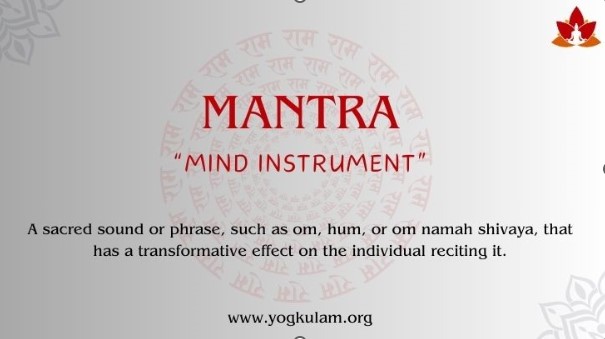
Mantras are ancient vibrational tools used in the spiritual traditions of Hinduism and Buddhism to concentrate the mind and connect with the divine. Today, they have gained fame in their ability to initiate meditation, healing, and spiritual awakening. Chanted for mental clarity, emotional balance, or spiritual growth, mantras offer powerful benefits that transcend time. As people continue to seek holistic practices to achieve wellness, mantras stand as an ageless activity that helps calm stress, cultivate inner peace, and connect with deeper meaning in life. Learn about mantras and bring some depth and richness to your well-being journey, and spiritual life.
A mantra is a word, sound, or phrase repeated in spiritual practices like meditation and prayer to focus the mind and align one's energy. It is derived from the ancient Sanskrit language: "man" meaning "mind" and "tra" - "instrument" or "tool." Hence, a mantra is often called a "tool for the mind," which helps practitioners achieve a state of mental clarity and inner peace.
For example, in the thought forms of Hinduism, Buddhism, and Jainism mantras are said to invoke divine energies, connect us with higher consciousness, or in achieving specific intentions like healing, protection, or enlightenment. In terms of vibrational quality, the mantras are said to affect the mind, body, and spirit of an individual to bring harmony within them and around them. Whether said out loud or whispered into a nearly inaudible whisper or silently repeated, mantras serve as an incredible medium for keeping the energy on track, realigning them with deep spiritual practice.

There are three main types of mantras: Bija or seed, Saguna with form, and Nirguna without form. Each has different qualities and serves to fulfill a different purpose in spiritual practice.
Bija mantras are single-syllable sounds that contain a great deal of vibrational energy. They are often used alone, although in reality, they are at their most potent when also included with other mantras, particularly Saguna mantras, to create even more power. Each Bija mantra has one of the seven chakras assigned to it and relates to a specific Hindu god or goddess, so they are part of the energy system and spiritual emphasis. Examples include "Om" for the crown chakra and "Lam" for the root chakra.
Saguna mantras call the name or form of a particular deity, which in turn will personalize the mantra and invite divine energy that the form contains. Chanting, it is said, calls forth the personification of the deity into being so the practitioner can connect directly with him.
Mantras are widely used in devotional practices, and most often they are found in Bhakti Yoga. Examples include "Om Namah Shivaya" for Lord Shiva and "Om Shreem Mahalakshmiyei Namaha" for Goddess Lakshmi.
Nirguna mantras, derived from ancient Vedic texts, are older than any of the three types.
Nirguna mantras do not call upon any particular deity or personalized attribute of God and therefore are much more abstract and difficult to interpret. These mantras relate to the universal truths of yogic philosophy and are said to encompass all of creation. They require a strong, focused mind as they are of highly abstract nature and are not recommended for beginners. An example of Nirguna mantra is "Aham Brahmasmi" meaning "I am Brahman" (the ultimate reality).
Chanting mantras has been utilized for centuries in all spiritual disciplines, not only as a form of bridging towards the divine but also for its positive effects on the mind, body, and spirit. Scientific studies and ancient wisdom agree on several benefits received from chanting 1. mantras. Here are some major benefits on mental grounds:
The stress is relieved because of the activation of the parasympathetic nervous system.
Levels of cortisol stress hormones decline.
Promotes concentration, mental clarity, and overall cognitive functioning.
Aids in lowering anxiety and raises mindfulness.
Develops emotional balance and positiveness
Aids in diverting the mind from all negativity
Makes one feel sensitive with emotions of compassion and inner peace.
Helps one to get emotional blockages through balance with emotions in them.
Improves the condition of blood pressure and promotes healthy heart functions
Aids in increasing breathing and lung powers through rhythmic breathing patterns
Synchronizes breath and rhythm, which reduces the rate of heartbeat.
Aids in reducing blood pressure or hypertension and generally facilitates physical relaxation
This helps the individual connect to higher consciousness and deeper meditation.
It produces vibrational frequencies that resonate with the universal energy.
Brings spiritual awakening and connection with divine power.
Helps to amplify one's ability to tap into the source of inner wisdom and spirituality.
The Spiritual Powers of Mantras
Mantras are not only used for focusing and meditation but also to unlock powerful spiritual powers. The vibrational energy emitted by chanting mantras is believed to resonate with universal vibrations, which will lead the individual to higher states of consciousness and even open up roads for deeper explorations in the spiritual realm.
How Mantras Are Supposed To Tap Into Spiritual Energies:
Mantras, sacred sounds such as "Om," are believed to elevate a person's vibrational frequency so that one is in alignment with the positive, high-frequency energy of the universe. Such vibrations move an individual toward a consciousness that produces higher inner peace and spiritual awareness. A higher vibration can create clear points of view as well as emotional balance.
Some mantras are even chanted to achieve protection and purification. These will establish a protective barrier of the soul around him. For example, "Om Namah Shivaya" is considered to be divine defensive energies that remove the negative and impure energies from one's mind, body, and soul. In this manner, there is deeper self-awareness and better meditation.
Mantras are also done to attract wealth, prosperity, and success. For example, by holding the right positive affirmation or mantras to specific deities, such as the Lakshmi mantra-"Om Shreem Mahalakshmiyei Namaha," one can align their intention with the energy of abundance, calling wealth, prosperity, and well-being in general to his life.
It is believed that constantly repeating mantras will deepen one's relationship with the divine or higher self. This will bring union with the universe, in turn opening up channels for the acquisition of spiritual wisdom and inner guiding insights. Mantras like "So Hum"-"I am That," which in effect allows the practitioner to acknowledge that he already has an existing relationship with all of existence-cultivate intense spiritual awareness.